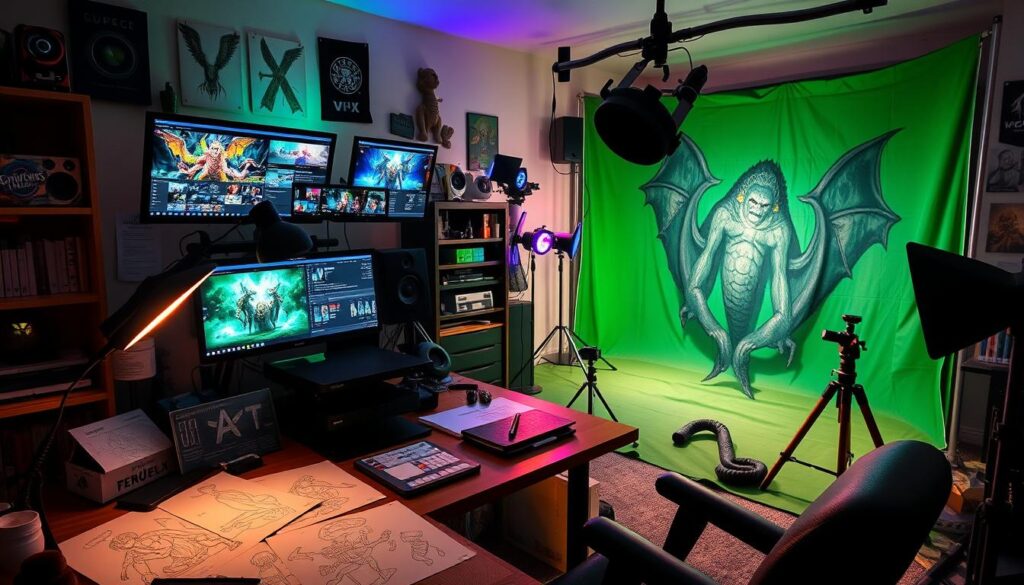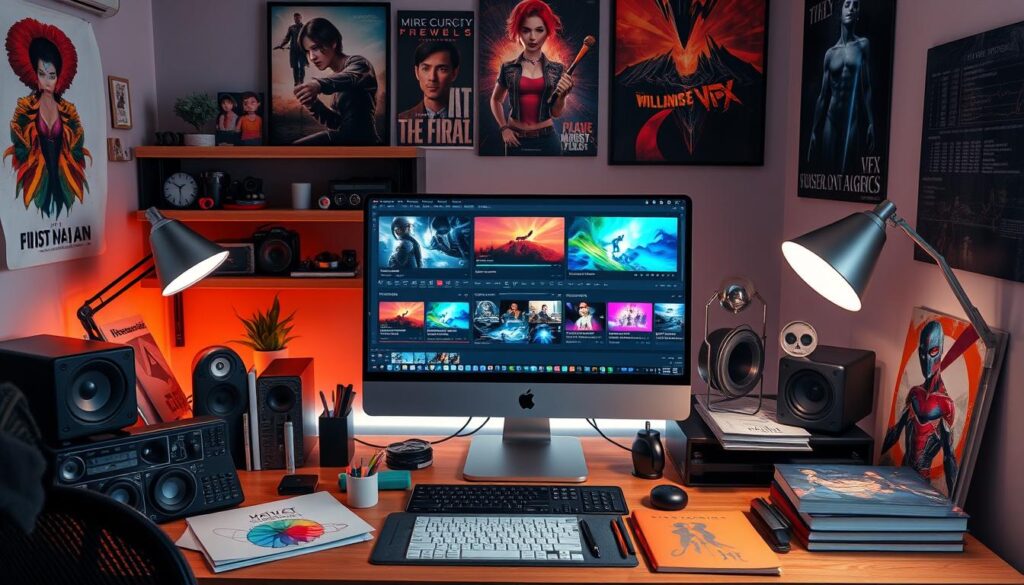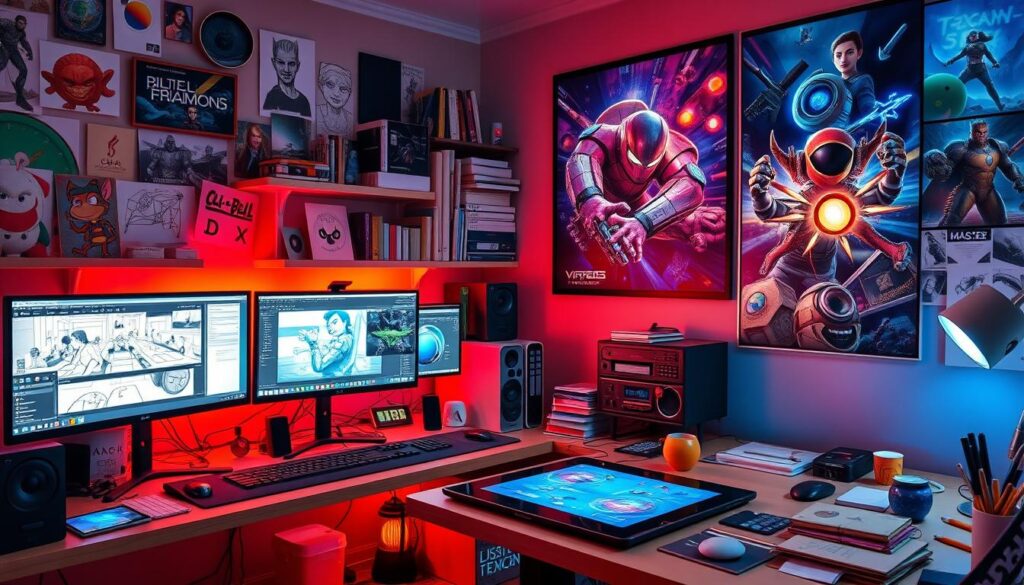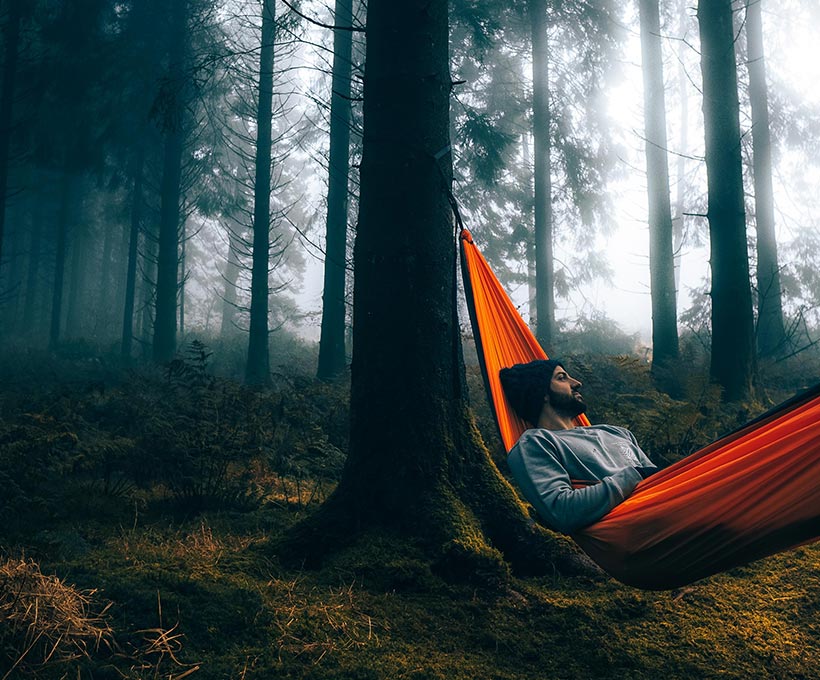In the world of filmmaking, visual effects (VFX) are key for storytellers. They help bring visions to life. Now, thanks to tech advances, you can make stunning VFX at home. This article will show you how to master VFX for your films.
We’ll cover the essential software, techniques, and workflows. You’ll learn how to make your visual storytelling stand out. And, you’ll see how to create professional-quality special effects without spending a lot.

Key Takeaways
- Discover the fundamentals of visual effects and their applications in filmmaking.
- Explore the essential software tools for creating VFX at home, including 3D animation, motion graphics, and compositing.
- Understand the techniques for modeling, texturing, rigging, and animating 3D elements.
- Learn the art of motion graphics and compositing to seamlessly integrate VFX into your films.
- Gain insights into rendering and post-production workflows to ensure a smooth VFX integration.
- Discover valuable resources for ongoing learning and improvement in the world of VFX.
- Elevate your visual storytelling and produce professional-quality special effects on a budget.
Introduction to Visual Effects
Visual effects, or VFX, are key in today’s movies. They help filmmakers make stunning images and mix digital parts smoothly. We’ll look at what visual effects are and how they’re used in filmmaking and post-production.
Understanding the Basics of VFX
Visual effects change and improve video to add things that can’t be done live. This includes adding digital creatures and backgrounds to scenes.
Making visual effects uses many techniques like 3D modeling and digital painting. These tools help mix real and imaginary parts, changing how stories are told.
Applications of VFX in Filmmaking
- Enhancing and transforming existing environments and landscapes
- Bringing fantastical creatures and characters to life
- Simulating natural phenomena, such as weather, explosions, and natural disasters
- Seamlessly integrating digital elements with live-action footage
- Creating visually stunning sequences that push the boundaries of imagination
Visual effects are very useful in filmmaking. They help filmmakers bring their ideas to life and wow audiences.
“Visual effects are not just a tool for telling a story – they are a way of inventing the world.”
– James Cameron, acclaimed filmmaker and visual effects pioneer
Essential Software for Home VFX
Creating stunning visual effects (VFX) at home is now possible. The world of vfx software, 3d animation, compositing, and rendering has grown a lot. This means you can explore your creativity from your own studio.
We’ve picked some key software tools for you. They can make your home VFX projects stand out. From 3D modeling and animation to compositing and rendering, these tools help bring your ideas to life.
Top VFX Software for Home Use
- Blender – A free and open-source 3D creation suite that offers a robust set of tools for 3d animation, modeling, and rendering.
- Adobe After Effects – A versatile compositing and motion graphics software that enables artists to create stunning visual effects and motion graphics.
- Autodesk Maya – A industry-leading 3D animation, modeling, simulation, and rendering software widely used in the film and TV industry.
- DaVinci Resolve – A comprehensive post-production solution that combines professional-grade compositing, color grading, and video editing capabilities.
- Unreal Engine – A powerful real-time 3D creation tool that offers advanced 3d animation and rendering capabilities for VFX and game development.
These are just a few amazing vfx software options for home VFX artists. Each tool has unique features to fit your needs and vision. By learning these essential tools, you can make your VFX dreams come true from your own space.

| Software | Key Features | Pricing |
|---|---|---|
| Blender | 3D modeling, animation, rendering, compositing | Free and open-source |
| Adobe After Effects | Compositing, motion graphics, visual effects | Subscription-based (part of Creative Cloud) |
| Autodesk Maya | 3d animation, modeling, simulation, rendering | Subscription-based |
| DaVinci Resolve | Compositing, color grading, video editing | Free and paid versions available |
| Unreal Engine | 3d animation, real-time rendering, game development | Free with optional royalty-based licensing |
Mastering 3D Animation
Step into the world of 3D animation, where virtual worlds come alive. Here, you’ll learn about modeling, texturing, rigging, and animation. These skills will boost your visual effects (VFX) abilities.
Modeling and Texturing Techniques
The base of great 3D animation is detailed models. Learn about 3D modeling methods, like polygonal and NURBS. You’ll see how to make your ideas real with accuracy. Then, master texturing to add depth and truth to your work.
Rigging and Animation Principles
Give life to your 3D models with rigging and animation. Understand skeletal systems and how joints work. This lets your characters move smoothly and naturally.
Learn the basics of animation, like timing and squash and stretch. These will make your animated figures lively and full of emotion.

“Animation is not the art of drawings that move, but the art of movements that are drawn.” – Norman McLaren
Mastering 3D modeling, texturing, rigging, and animation opens up VFX’s full potential. Start creating stunning 3D content. It will draw in your audience and take your stories to new levels.
Motion Graphics and Compositing
Making motion graphics and compositing look great is key in visual effects (VFX). Adobe After Effects is a top tool for VFX artists. It helps create amazing motion graphics and blends different elements smoothly.
Creating Visual Effects with After Effects
After Effects lets VFX artists mix and change many things. This includes video, images, 3D models, and animated graphics. It’s great for making stunning visual effects that take viewers to new places.
Working with After Effects means knowing how to key, mask, and color correct. It also means being good at motion graphics. This is about making text, shapes, and other graphics move to tell a story and look good.
| Key Capabilities of After Effects | Practical Applications |
|---|---|
| Compositing Motion Graphics Keying Masking Color Correction | Seamless integration of live-action footage and digital elements Creation of dynamic titles, lower-thirds, and animated graphics Removal of unwanted background elements Adjustment and enhancement of visual aesthetics |
Using motion graphics and compositing in After Effects makes projects look better. It grabs the audience’s attention and makes the movie or show more exciting.
Rendering and Post-Production Workflows
Creating stunning visual effects (VFX) for your projects needs a smooth workflow. The steps from rendering high-quality images to adding VFX to your films are key. We’ll look at how to make your post-production pipeline better and ensure your VFX work is a hit.
Integrating VFX into Your Films
Making VFX blend well with your films is a careful task. Here are some important points to keep in mind:
- Set up a strong rendering pipeline to get images that match your live-action footage perfectly.
- Create a post-production process that makes combining VFX with your footage easy and looks great.
- Use the best VFX integration methods to smoothly mix practical and digital parts, making your film feel real and engaging.
By following these steps, you can make the most of VFX and take your filmmaking to the next level.
“The key to successful VFX integration is maintaining a consistent visual aesthetic throughout the entire film. Every element, from live-action to digital, must work in harmony to create a cohesive and believable world.”
Good rendering and post-production workflows are the base for great VFX integration. Knowing and improving these steps helps you bring your ideas to life with great detail and truth.
Resources for Learning VFX
Are you dreaming of becoming a filmmaker or a skilled visual effects artist? The world of VFX is always changing. Luckily, the internet is full of online tutorials and courses to help you improve your skills.
Online Tutorials and Courses
YouTube, Skillshare, and Udemy have lots of free and affordable tutorials. They cover topics like 3D modeling, animation, compositing, and motion graphics. These are great for those who learn best by doing.
Coursera, edX, and LinkedIn Learning offer more in-depth courses. They focus on the theory and technical sides of visual effects. These courses are taught by experts in the field.
If you want a deeper dive, look into online VFX degree or certificate programs. These are offered by top universities and film schools. They give you a set curriculum, feedback, and a chance to work with professionals and others in your field.
FAQ
What software do I need to create VFX at home?
To make VFX at home, you’ll need some key software. Use 3D animation tools like Blender, Maya, or Cinema 4D. Also, compositing programs like Adobe After Effects are crucial. Don’t forget rendering engines like Cycles or Redshift. These tools help you model, animate, and mix different visual elements into one final product.
How do I get started with 3D animation for VFX?
Starting with 3D animation for VFX means learning the basics. First, get familiar with 3D software like Blender or Maya. Then, learn how to create detailed models, add textures, and set up rigs. Finally, practice animating to bring your models to life.
What is the role of motion graphics and compositing in VFX?
Motion graphics and compositing are key in VFX. They let you mix and adjust different visuals. With Adobe After Effects, you can make stunning effects by keying, rotoscoping, and adjusting colors. Learning these skills helps you blend 3D elements, live-action footage, and other visuals into a stunning final product.
How do I ensure a smooth rendering and post-production workflow for my VFX projects?
For top-notch VFX, optimize your rendering and post-production. Learn the best rendering practices, like using efficient engines and settings. Also, use GPU acceleration. A smooth post-production process lets you easily add your VFX to films, making them look professional.
What resources are available for learning VFX?
There are many ways to learn VFX. Online tutorials, video courses, and communities are great resources. YouTube, Udemy, and Skillshare have lots of VFX lessons. Joining forums and communities also helps with feedback, insights, and networking.

